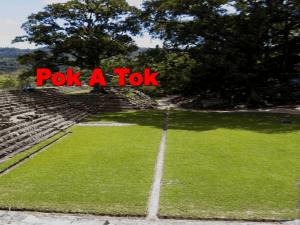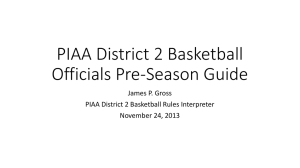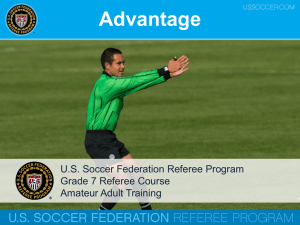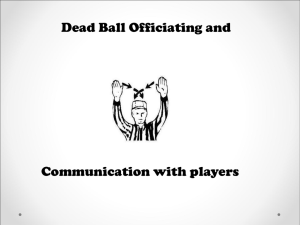the Outdoor Rule Interpretaions for
advertisement
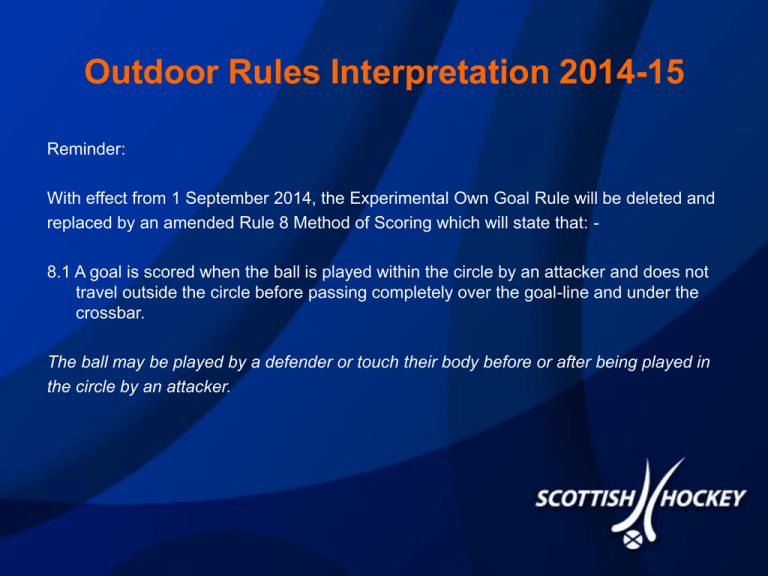
Outdoor Rules Interpretation 2014-15 Reminder: With effect from 1 September 2014, the Experimental Own Goal Rule will be deleted and replaced by an amended Rule 8 Method of Scoring which will state that: 8.1 A goal is scored when the ball is played within the circle by an attacker and does not travel outside the circle before passing completely over the goal-line and under the crossbar. The ball may be played by a defender or touch their body before or after being played in the circle by an attacker. Playing the Ball in the Air Scottish Hockey will implement the International Hockey Federation (FIH) Rule and Regulation concerning Playing the Ball Above the Shoulder for the 2014-15 season onwards. Rule 9.7: Players must not play the ball with any part of the stick when the ball is above shoulder height except that defenders are permitted to use the stick to stop or deflect a shot at goal at any height. Regulation: Players may play the ball above shoulder height provided that it is not dangerous or leading to danger This will be applied to the following competitions: - Men's National League, Play-Offs, and Regional League - Women's National League, Play-Offs, and Championship League - Men's Scottish Cup and Plate - Women's Scottish and Plate This differs in context from last season's rule, when use of the European Hockey League (EHL) interpretation of the rule was implemented. Penalty Corner Rule 13.3.h: Until the ball has been played, no attacker other than the one taking the push or hit from the back-line is permitted to enter the circle and no defender is permitted to cross the centre-line or back-line. Regulation: Until the ball has been played, no attacker other than the one taking the push or hit from the back-line is permitted to enter the circle and no defender is permitted to cross the centre-line or back-line. a For any offence of this rule by a defender on the back-line, other than the goalkeeper, the offending player is required to go beyond the centre-line and cannot be replaced by another defender. b For any offence of this rule by a defending goalkeeper or player with goalkeeping privileges, the defending team defends the penalty corner with one less player: ie the corner is defended by one less player than before this incident. c For an offence of this rule by an attacker who enters the circle before the ball is played, the offending player is required to go beyond the centre line. d If the player taking the push or hit from the back-line feints at playing the ball, the offending player is required to go beyond the centre line but is replaced by another attacker; if this feinting leads to what would otherwise be a breach of this rule by a defender, only the attacker is required to go beyond the centre line e Subject to the above, the penalty corner is re-taken. f If another breach of Rule 13.3.h as described in this regulation occurs during the re-taken penalty corner, further consequences apply as specified above (eg for a second offence of this rule by a defender on the back-line, the team defends the penalty corner with not more than three players). g A subsequent penalty corner (as opposed to a re-taken penalty corner) may be defended by not more than five players. Match Preparation ● Be thorough in your match preparation ● Make sure that you have a game plan for every match ● The game plan should be discussed between you and your fellow umpire before the match !!!! ● Have a personal action plan – try to improve something every match ● Maintain your fitness level ● Look after yourself – eating, drinking, resting … always be prepared and consider weather etc ● Make sure you arrive in good time for every match and remember YOU are responsible for ensuring that the match is started promptly whether or not all the players are present The Match Be yourself at all times Help the players – the players need to understand what you want Teamwork and co-operation are critical – let’s help and support each other Be aware of the areas of the pitch where your colleague could need assistance If you have to, take time in making decisions Try to get the decisions correct and consistent between the two of you Use common sense - understand the players’ intentions Management Encourage the game to flow by only interfering when necessary However do not lose your grip on the match as a result of allowing too much flow! Allow the players to contest the ball Allow as much advantage as possible Read the game – do not ball watch Sometimes a free hit is a better advantage and causes less frustration Whistle timing is critical Flow Be pro-active. Prevention is better than cure Set standards early – TALK to the players Make it easy on yourself – get them 5 metres at free hits from the beginning Recognise early when the ball is not in the right place for the free hit - avoid replays Ensure free hits are taken correctly Change your game plan if you need to Communicate with your colleague Tackling Watch tackles carefully – only penalise if you are sure there has been an offence Do not penalise just because there is a noise or it looks bad Do not penalise if the tackler initially appears to be in an impossible position from which to make a legal tackle Watch which direction the ball travels Be strict on the breaking down of play and intentional stopping tackles Be aware of intentional shielding and body blocking Obstruction Are the players trying to play the ball? Is there a possibility to play the ball? Is there active movement to prevent the playing of the ball? Be aware of professional use of the body to illegally block opponents from the ball Ball off the ground Blow only in dangerous situations everywhere on the pitch – forget lifted, think danger Use common sense and show understanding of the play Be consistent as an individual and as a team Overhead Balls Set up free hits correctly, make sure that the players are 5 metres from the ball The ball may be raised immediately from a free hit using a push, flick or scoop, but must not be raised intentionally using a hit Watch the ball on the way up – the ball must not be flicked dangerously towards an opposing player The ball landing – apart from the receiver, players must stay 5 metres away Penalise poor skill when the receiver makes the ball dangerous Goalkeepers Goalkeepers wearing protective headgear may only take part in the game within their own 23 metres area A player with goalkeeping privileges must not take part in the match outside the 23 metres area they are defending when wearing the protective headgear but may remove the headgear and take part in the match anywhere on the field At penalty corners, an injured or suspended goalkeeper may only be replaced by a similarly attired goalkeeper i.e. a goalkeeper wearing only protective headgear may not be replaced by a fully kitted Goalkeeper Goalkeepers Allow goalkeepers to move the ball away with their hand / hand protector / arm /body, as part of a goal saving action Permit this action in situations where attackers have an opportunity to score or attempt to score a goal, so it can also be used to deny attackers the possibility of possession of the ball or another shot at goal Be aware that goalkeepers who intentionally propel the ball over long distances should be penalised with a penalty corner Rules of Hockey If a team uses only field players, no player has goalkeeping privileges – following the award of a penalty corner it is not permitted for one of the on field players to assume goalkeeping privileges by putting on a different coloured shirt and/or protective headgear Substitutions are allowed at penalty strokes; but if a team chooses to defend a penalty stroke with a player who is taking part in the game as a field player, this will not be considered as a substitution so they may only wear a face mask as protective equipment and may only use their stick to make a save Penalty Corners Positioning is critical – sell decisions Manage the set up – including the meetings on the top of the circle or in defence Co-operation needed if runner is hit – above or below the knee? Position of disengaged umpire should allow support of colleague on the height and direction of the shot, the possibility of suicide runners and possible obstruction of runners When the ball is missing the goal and the defender is hit high on the body, decision is a free hit to the defence Penalty Corners If a player defending a penalty corner continues to wear a face mask after the corner has been completed a free hit should be awarded. Repetition means another free hit and appropriate card Players should, however, be allowed to complete a defending action, even if it means that they play the ball just outside the circle when wearing a face mask – common sense should prevail Penalty Strokes No personal interpretations Stick to the Rules and guidance Sell decisions Ensure that goalkeeper and taker are in position and prepared Taker to be within playing distance of the ball communicate this early Appealing Appealing for free hits – abuse or shouting spoils the game Do not allow comments at every penalty corner you award Harassment, intimidation and surrounding of umpires after decisions should not be tolerated Make it easy on yourself – use your skills and the tools at your disposal to stamp these problems out early in the game We all need to do this every match!


